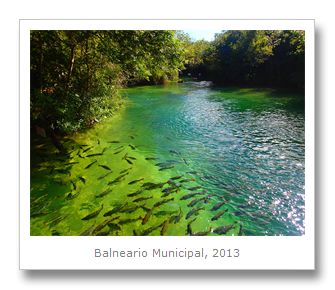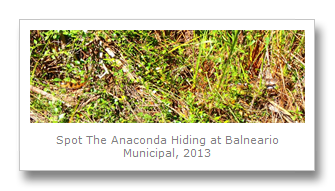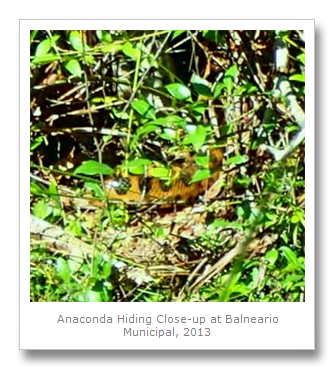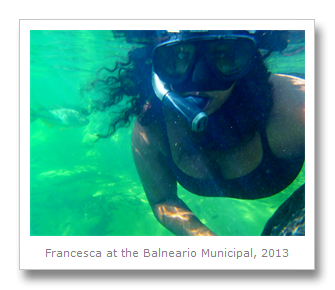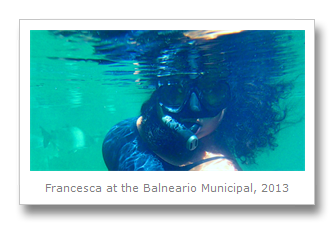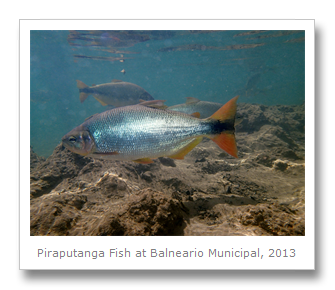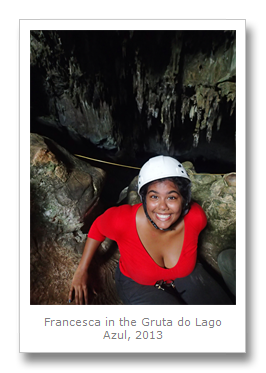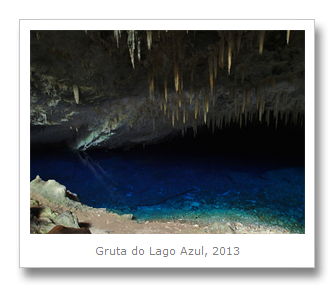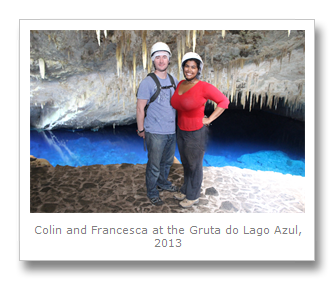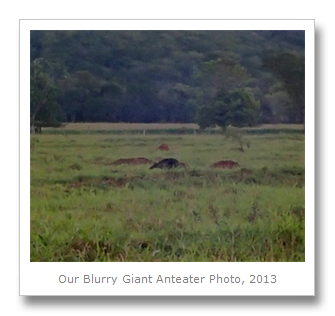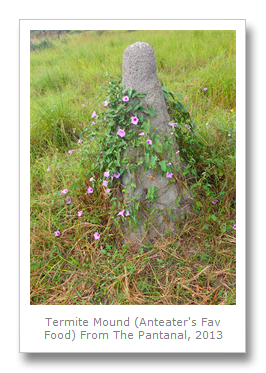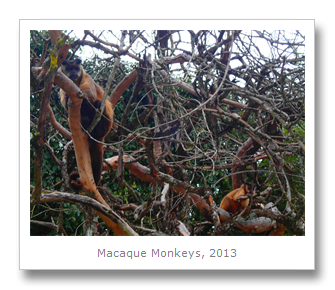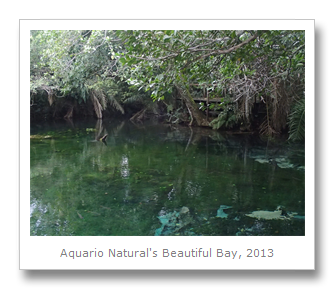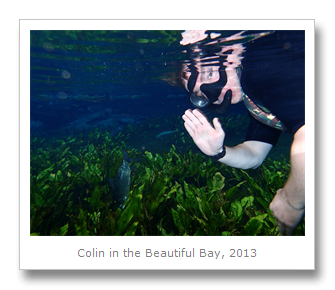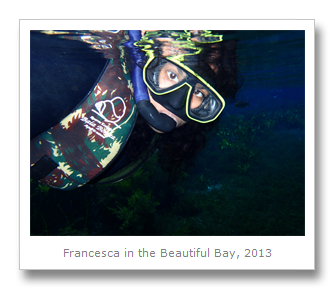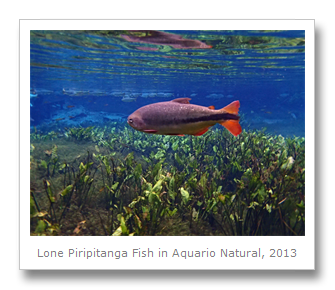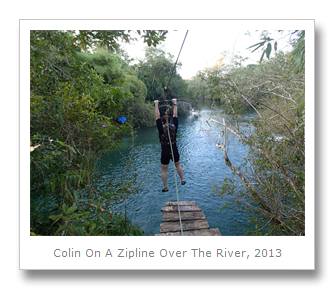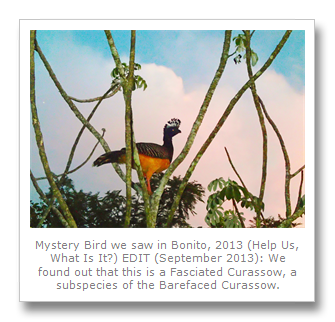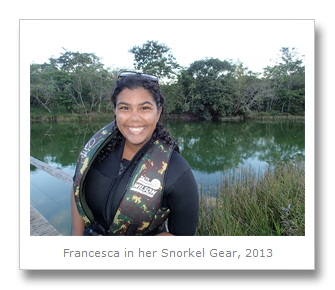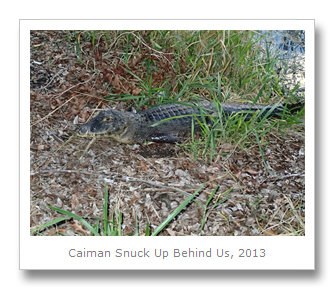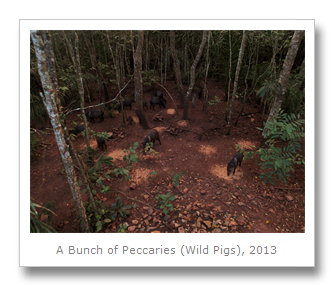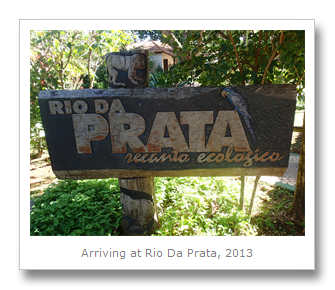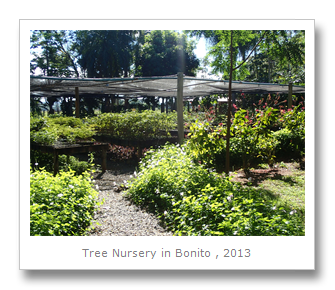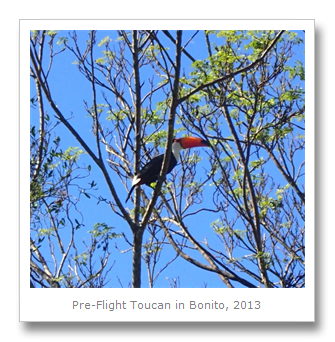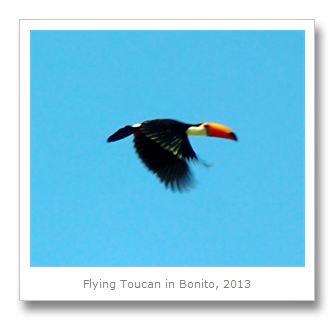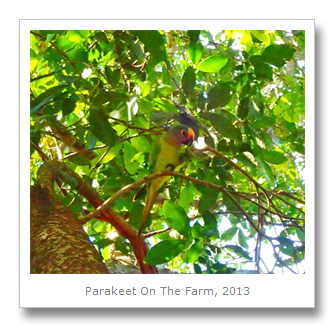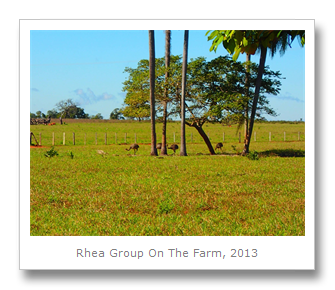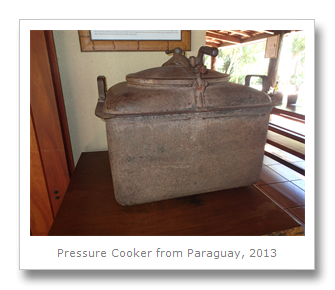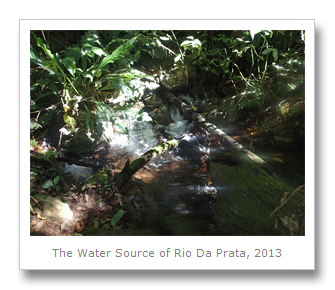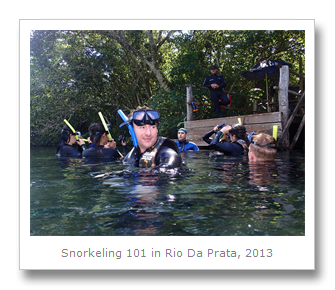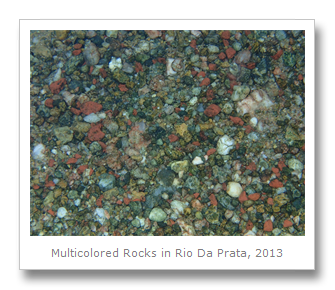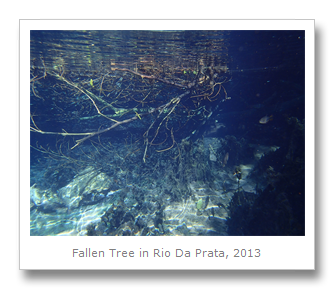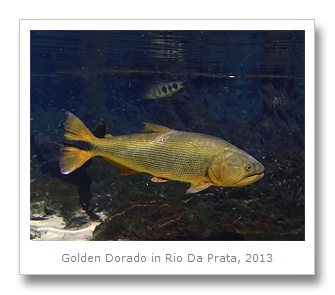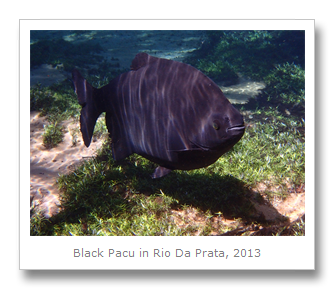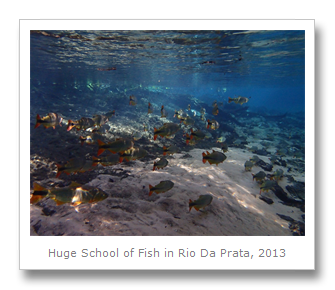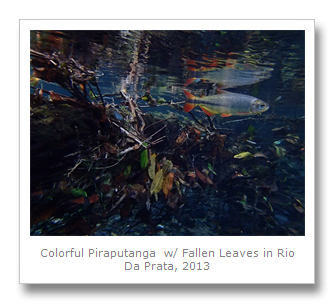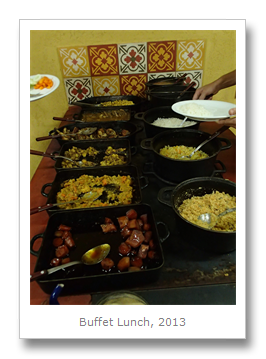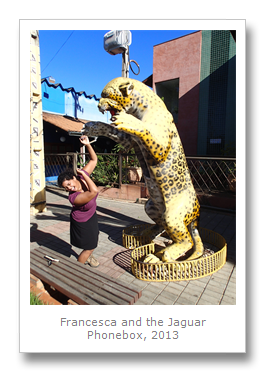When we got to Bonito and checked into our hotel, we decided we needed more information about the different snorkeling trips we could do. Everything seemed pretty costly (transportation is not included to the tours, since most of them are on private land) so we could only choose a few of the best. Thankfully, our hotel was just a 2 minute walk away from the Hostelling International (Bonito HI) and while we didn’t stay there (our place was actually cheaper) we arranged and booked all of our tours with them. They even gave us the great suggestion to take motorcycle taxis to the Balneario Municipal, a snorkeling area with tons of big fish to swim with.
We confirmed our tours the morning of June 1st, then sped off with our drivers for an afternoon at the Balneario Municipal. The snorkeling wasn’t out in the open ocean, but in part of the 120 km Formoso river – gorgeous transparent waters which have natural limestone dams on a plateau that formed almost 600 million years ago. The limestone dams form ‘swimming pools’ with numerous plants and fish – and we were eager to explore them. This area actually has the highest concentration of calcareous tufa (a specific type of limestone) in all of South America, a tufa that continuously grows to form new dams and waterfalls.
However, before we made it into the water we noticed a group of people gathered together at the end of one dock. They were talked and pointing at one of the little natural grass ‘islands’ in the center of the river, just a 10 feet or so from the dock. I walked over, wondering what they had discovered. I overheard someone say ‘cobra’ which means ‘snake’ in Portuguese, and the word ‘sucuri.’ I didn’t know what that word meant then, but I know now that it translates to ‘anaconda.’ That’s right! We had left the Amazon and the Pantanal, but it hadn’t left us. Our first spot of a wild anaconda was in Bonito, not normally a place known for its wildlife. Later I found out that Bonito is actually dubbed ‘anaconda heartland’ and snakes as long as 25 feet have been found in the region.
Our first venture into the water woke us up – it was freezing cold! The water was absolutely beautiful though, some of the clearest water I’ve ever seen! Colin and I could see fallen trees at the bottom of the river with amazing clarity. We snorkeled around for a couple hours, taking our time exploring the river, hesitating only when we approached the little island which was the current home of the anaconda we spotted earlier. As we swam near to it, Colin and I stopped for a moment by the crowd. We couldn’t see the snake in the grass anymore – and it didn’t seem like it was hiding there. Colin told me he saw something in the water that was long and patterned just like the snake flash by him when we approached, so we’re pretty sure it slid off the island and into the water near us. Snorkeling with the anacondas!
We finished up our swim and had some lunch and a short walk while waiting for our motorcycle taxis to come back for us. Once we returned to the hostel, we confirmed our tours for the next day and headed back to the hotel to rest from the swim.
Despite the rain the evening before, the next morning we were venturing towards a cave with stunning bright blue water! We were picked up from our hotel in a taxi and brought to the Gruta do Lago Azul, where we were given helmets, and told it was going to be a slippery, steep walk down. I was quite nervous after my fall on Fernando de Noronha, and my general fear of slippery rocks, but I was determined to make it down to the bottom… with the guide and Colin’s help walking the whole way down, if needed!
It was not an easy journey down at all. I had read on TripAdvisor that many people found it too difficult and didn’t make it the whole way – some even saw the decent and turned around at the start like two of the people in our group that morning. There were 5 separate platforms to make it to, each one providing a slight stop and rest to see the lake and wait for the group ahead to move on.
While I couldn’t see the lake from the cave entrance, once we descended the 100 meters worth of stone steps, I began to see one of the bluest lakes I’d ever seen – and it got even more blue in color the closer we got to it and its 90 meter depth. Discovered in 1924, the cave has some interesting features, such as blind albino shrimp that are only found in this cave and in Africa, indicating a closed environment. In 1992, an expedition discovered fossils including some belonging to a Pleistocene era (6 to 10,000 years ago) saber-toothed tiger and giant sloth. I knew Colin would be excited about going anywhere that had giant pre-historic sloths!
After a slightly easier climb out of the cave, we got ready to return to the city before our next tour. On the way back, we spotted a ton of rhea and other birds. But then something extra special caught our eye… it was the extremely elusive giant anteater! Yay, we had finally seen one in the wild – and we weren’t even in the Pantanal. While it was quite far away munching on termite mounds, we had our binoculars with us and watched it roam through the grass for a while.
The giant anteater we saw must have been around 6 feet in length, but they can grow up to 7 feet in length. They also have this crazy looking long nose and huge bushy tail – the tail actually makes up most of their body. While its name indicates it slurps up ants they eat termites as well, all done with a 24 inch long tongue which moves 160 times per minute when it feeds – that’s 3 times per second. We were really lucky to see a giant anteater when we did – they are typically nocturnal and can only been seen at night or early in the morning… and we saw one in the afternoon!
These animals are so weird in their look and habits, but they are even more peculiar when you look at who their relatives are: The giant anteater and the sloth are related to each other. I know, it sounds really strange, but they are. There is another kind of anteater which lives in trees, so we can see the connection between the two there. Plus they do look a bit similar, if you ignore the massive difference in noses. Those two are related to a larger group that includes the armadillo.
I’ll leave you with a cool myth from The Cosmic Zygote by Peter G. Roe about the anteater, told by the native people of the Amazon:
Why the Jaguar and the Anteater Are Enemies
One day, when the anteater and the jaguar went to bathe in a lake, the
anteater challenged the jaguar to a swimming contest,saying,“I can stay
underwater without breathing longer than you can.” The jaguar indignantly denied the anteater’s assertion and suggested that they both immerse themselves to see who could remain below the waters the longest without coming up to breathe. Both removed their taris [“cotton ponchos,”but here metaphorically intended to mean their pelts] and stepped into the water. The anteater said, “Why don’t we go under at the same time so we can time ourselves exactly”; the jaguar, agreeing, submerged. But the anteater was only tricking him and jumped out of the water. He stole the jaguar’s beautiful tari. He put it on and ran away, leaving his old ugly one behind. When the jaguar finally surfaced, gasping for air, he discovered his loss and the fact that he had been tricked. Angry, he had to put on the old anteater’s tari before he could chase after him. Nowadays the jaguar is really the anteater and the anteater the jaguar beneath their respective skins. That is why they fight and are enemies. (Roe, 190)
We wanted to get a closer look, but there wasn’t a way in past the fence – the anteater was feasting on private cattle land. Back in the car we went, returning to the hotel for a simple lunch in the room we ordered for delivery. That afternoon we went back to the HI to take another round of motorcycle taxis to our afternoon snorkeling spot – Aquario Natural. We spent a little time in the pool and watching some nearby monkeys (or more accurately worded, hiding from them) while waiting for our tour to start. This snorkeling place required us to done a wetsuit the water was so cold, plus a lifejacket, special shoes… then we took a walk down to the water. Colin and I were desperate to get away from the mosquitos which seemed to be everywhere around us, so we splashed into the water as soon as it was possible.
Once in the water we saw tons of fish and even more plant life. We snorkeled with 35 different species of fish including piraputanga, golden dorados, and piaus in the area called the Beautiful Bay. Again, the stunningly clear transparency of the water is due to the abundant limestone. And we were so grateful for that limestone! The snorkeling in this river was some of the best I’ve ever seen, definitely the best I’ve ever seen in a river system. We snorkeled all around the area, then down the river while some other members of our party with young children rode in a boat alongside us. It was 1.5 hours of amazing beauty!
Once we got to the end of the snorkeling, our guide told us he had a special treat for us. We walked down the path not knowing what was coming up until we saw it – a zipline over the water! I was freaked out, but knew I had to do it. After I flew down the zipline, dropping into the water it was Colin’s turn. He had never done a zipline before, but he thought he’d give it a go as well! Here’s a photo the guide took of him zooming down above the water!
Post zipline, we headed back to the main changing area along a nature trail. We took quite a while on the trail – and saw a lot more animals than expected! I posed for a photo when Colin noticed the first animal we saw: a caiman creeping up on me! We walked down the long wooden bridge across the swampy land we had just been swimming and snorkeling in past 4 or 5 different caiman, and many more we couldn’t see. We fell a bit back behind the rest of the group while taking a photo of a funny-looking bird, but we were glad we did. Moments later Colin heard a rustling noise while I was snapping the bird’s photo and we turned and saw a fat little capybara rolling around in the swampy muck. Lucky! While I was busy taking a video of the capybara, Colin yelled for me to look up. When I did I saw a group of 4 toucans diving gracefully through the air above our heads! There were animals everywhere! There were even a group of wild pigs known as peccary towards the end of the walk back, though I think they might be owned by the Aquario Natural park.
Our motorcycles were waiting for us by the time we got back, so we quickly stripped our cold wetsuits off and rode with the drivers back to the hotel. This ride was fantastic – because of the late afternoon time we got to see a colorful sunset as we zoomed through the countryside and into the city before being dropped off for rest and a pizza.
The morning of June 3rd was reserved for our Rio Da Prata visit. This one was a full day trip which included time in the morning to lounge at their meeting center in the countryside. This time we went in a van with a bunch of other guests from HI and drove through beautiful scenery until we reached a house with tons of hammocks around it and different signs up describing the various birds, animals, and fish in the region. There were flowers all around, and a walk around the place revealed both a large vegetable garden and a ‘native tree nursery’ where 55 different species of trees were being grown.
Passing through this, we ended up towards the back of the farm, we heard something up in the trees. More toucans! This time there were three of them sitting together in plain view. We stood below them taking photos and they started making noise and moving about. Suddenly, two more toucans flew over to see what was the big deal! 5 huge beautiful toucans in one tree. Amazing and colorful, toucans’ light keratin beaks make up more than half the length of their body and their 6 inch tongue help them eat all the fruit they can get. That’s why they are my favorite bird…
On the farm we found an old pressure cooker from Paraguay which had an interesting story. Turns out that in 1869, at the end of the War of the Triple Alliance (also known as the Paraguayan War,) this pressure cooker was bartered in exchange for a cow. The pressure cooker was formally used to cook food for the troops during the war. The war was the bloodiest that has occurred in South America involving Paraguay attempting to expand its territory and thus fighting the allied group of Argentina, Uruguay, and Brazil. The conflict killed around 400,000 people, and this pressure cooker saw and survived the battle. A neat little bit of history! The cooker ended up at the farm when it was brought as a gift from its former owners who received it for the cow back in the 1800’s.
Once our appointment time came up, we got up from our hammocks and headed to put on our wetsuits. We hopped in the back of a truck and sped off to the main spring of Olho d'Água River ready to snorkel again and eager to compare this venture with the previous river. Walking past the water source, we got in at the river start and promptly realized we hadn’t picked the most advanced tour ever. I’m not sure if it was because the tour is on private land or what the situation was but we spent nearly 45 minutes doing what seemed like a “Snorkeling 101” class. Colin and I got pretty bored, so we splashed around in the water during this time, enjoying the clarity while everyone else was learning how to blow air out of their snorkel tube.
Once they were finished, we snorkeling in a big circle around the first lagoon, which had a lot less plants and a lot more fish than the Aquario Natural. In fact, the diversity of the fish here is much more extensive – over 55 different species of fish are in Rio Da Prata! Colin and I floated downstream well behind everyone else enjoying the journey until we reached where the Olho D'Água meets with the Rio da Prata. Our 3 hour snorkel that showed us some huge fish including Piraputanga (red tail), Curimbata (blue bottom feeder), Pacu (black) and the ultra-creepy Golden Dorado predator.
It was totally surreal snorkeling in a river when above us was an area full of green forest – it just didn’t look like the kind of place you’d snorkeling in! Once we reached the end of the river (after numerous starts, stops, and walks, then back in the water at various points) we took the car back to camp for a filling buffet lunch of local dishes which was one of the best buffets in Brazil! (I loved all the sauces and tender beef.) Our day complete, we chatted with some locals on the way back to Bonito. One of the girls confirmed my suspicions about the educational system in Brazil – she was so fed up with the cost and the poor quality she gave up studying physics to work at Outback Steakhouse in Sao Paulo! Sad.
We booked our bus tickets the following day for the next evening, then spent the day walking around the town and dining at the Pantanal Grill. This we did because it sounded cool, plus we wanted to fulfill a special request from my brother Anthony to have more strange food features in our blog! This place was known for its exotic animals on offer (don’t worry, none of them endangered – all of these animals are farmed for consumption) and Colin and I decided to go with the capybara and the peccary. Our capybara came wrapped in bacon and loads of spices. I would describe the taste as perhaps “slightly gamey yet juicy pork-flavored.” Very filling, like a rich flavorful sausage. The peccary wasn’t nearly as good, tasting like pork also but being completely dry and very gamey and tough to chew – not really any special flavor. I didn’t even finish all of mine and stuck with the capybara and the sides.
Later I learned that the book Curiosities by Charles Case notes that the Roman Catholic Church, supposedly gave the capybara the status of fish to allow its consumption during Lent, reasoning the webbing in its feet makes it a great swimmer and time in the water somehow equals fish. According to Emilio Herrera, a biologist and capybara expert at Universidad Simon Bolivar in Caracas Venezuela, the capybara is indeed eaten by many Venezuelans during Lent because while “…it doesn't even look like a fish… [it] has hair and four legs,” it does in fact swim. Hmm.
The next afternoon we boarded our bus for Foz, which was going to be an all-night affair. From Bonito to another city called Dorados, then switching buses and on to Foz. We actually ended up switching buses twice because there was something wrong with one of our buses. What a night! I’ll let Colin continue with our time in Foz… and waterfalls!
Francesca
